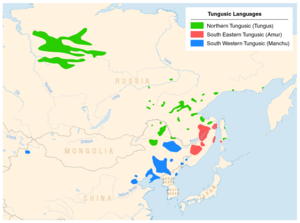Northern Tungusic languages
| Tungusic | |
|---|---|
| Geographic distribution |
Siberia, Northeast China |
| Linguistic classification | Isolated family of the world's primary language families |
| Subdivisions |
|
| ISO 639-5 | |
| Glottolog | tung1282 |

Geographic distribution
|
|
The Tungusic languages /tʊŋˈɡʊsɪk/ (also known as Manchu-Tungus, Tungus) form a language family spoken in Eastern Siberia and northeast China by Tungusic peoples. Many Tungusic languages are endangered, and the long-term future of the family is uncertain. There are approximately 75,000 native speakers of the dozen living languages of the Tungusic language family. Some linguists consider Tungusic to be part of the generally-rejected Altaic language family, along with Mongolic, and sometimes Koreanic and Japonic.
The term "Tungusic" is from an exonym for the Evenk people used by the Yakuts ("tongus") and the Siberian Tatars in the 17th century meaning "pig". It was borrowed into Russian as "тунгус", and ultimately into English as "Tungus". It became a broad term for speakers of the whole family, "Tungusic". Use of "Tungus" is now discouraged; the Russian government now uses the endonym "Evenks" officially.
Linguists working on Tungusic have proposed a number of different classifications based on different criteria, including morphological, lexical, and phonological characteristics. Some scholars have criticized the tree-based model of Tungusic classification, arguing the long history of contact among the Tungusic languages makes them better treated as a dialect continuum.
One classification which seems favoured over others is that the Tungusic languages can be divided into a northern branch and a southern branch (Georg 2004):
...
Wikipedia
